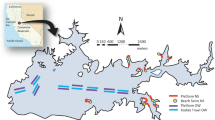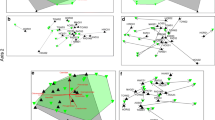Abstract
Many studies either ignore chironomids or only identify specimens to subfamily or tribe due to the associated difficulty and high cost with processing and identifying larvae. An efficient form of sampling chironomids involves collections of surface-floating pupal exuviae (SFPE). SFPE sample sorting has been shown to be more time efficient than traditional dip-net methods in temperate urban and peri-urban streams. However, no published studies have tested the time efficiency of SFPE sample sorting from coastal tropical aquatic systems. We calculated sort times for SFPE samples collected from a coastal tropical stream and an estuary and used multiple linear regression analysis to quantify the relationship between sample sort time and number of specimens, average body length of specimens, and dry weight of sample residue. The average amount of time required to sort very small samples was 69.3 min, while moderate samples averaged 85.6 min and large samples averaged 153.5 min. However, on average, small samples were nine times more time consuming per specimen than large samples. Additionally, dry weight of small-sized residue and the number of specimens contributed significantly to sort time. Therefore, we recommend collecting larger samples, which can be achieved by sampling for 20 min over 200-m reaches for stream sites and 500- to 1,000-m reaches for riverine and estuarine sites. Also, we suggest collecting during periods of low wave action and disturbance by boat wake to reduce the amount of sample residue. This research will enhance project planning and budgeting of future studies using the SFPE method to monitor coastal tropical aquatic systems.



Similar content being viewed by others
References
Anderson, A. M., & Ferrington, L. C. (2012). Time-efficiency of sorting Chironomidae surface-floating pupal exuviae samples from urban trout streams in Northeast Minnesota, USA. In E. E. Stur & K. Aagaard (Eds.), 18th International Symposium on Chironomidae. Trondheim, Norway: Fauna norvegica.
Armitage, P. D., Cranston, P. S., & Pinder, L. C. V. (1995). The Chironomidae: biology and ecology of non-biting midges: Chapman & Hall.
Ashe, P., Murray, D. A., & Reiss, F. (1987). The zoogeographical distribution of Chironomidae (Insecta: Diptera). Annales de Limnologie, 23(1), 27–60.
Barbour, M. T., Gerritsen, J., Snyder, B. D., & Stribling, J. B. (1999). Rapid bioassessment protocols for use in streams and wadeable rivers: periphyton, benthic macroinvertebrates and fish. (2nd ed., Vol. EPA 841-B-99-002) (2nd ed.). Washington, D.C.: U.S. Environmental Protection Agency, Office of Water.
Bouchard, R. W., & Ferrington, L. C. (2011). The effects of subsampling and sampling frequency on the use of surface-floating pupal exuviae to measure Chironomidae (Diptera) communities in wadeable temperate streams. Environmental Monitoring and Assessment, 181(1–4), 205–223.
Box, G. E. P., & Cox, D. R. (1964). An analysis of transformations. Journal of the Royal Statistical Society. Series B (Methodological), 26(2), 211–252.
Coffman, W. P. (1973). Energy flow in a woodland stream ecosystem: II. The taxonomic composition of the Chironomidae as determined by the collection of pupal exuviae. Archiv fur Hydrobiologie, 71, 281–322.
Ferrington, L. C. (2008). Global diversity of non-biting midges (Chironomidae; Insecta-Diptera) in freshwater. In E. V. Balian, C. Lévêque, H. Segers, & K. Martens (Eds.), Freshwater animal diversity assessment, Developments in Hydrobiology, Vol. 198 (pp. 447–455). Netherlands: Springer Netherlands.
Ferrington, L. C., Blackwood, M. A., Wright, C. A., Crisp, N. H., Kavanaugh, J. L., & Schmidt, F. J. (1991). A protocol for using surface-floating pupal exuviae of Chironomidae for rapid bioassessment of changing water-quality. In N. E. Peters & D. E. Walling (Eds.), Sediment and stream water quality in a changing environment: trends and explanation. Oxfordshire, U.K: International Association of Hydrological Sciences Press.
Ferrington, L. C., Berg, M. B., & Coffman, W. P. (2008). Chironomidae. In R. W. Merritt, K. W. Cummins, & M. B. Berg (Eds.), An introduction to the aquatic insects of North America (4th ed., pp. 847–989). Dubuque, IA: Kendall/Hunt Publishing Company.
Hirth, H. F. (1963). The ecology of two lizards on a tropical beach. Ecological Monographs, 33, 83–112.
Jones, F. C. (2008). Taxonomic sufficiency: the influence of taxonomic resolution on freshwater bioassessments using benthic macroinvertebrates. Environmental Reviews, 16, 45–69.
Jongman, R. H. G., Ter Braak, C. J. F., & van Tongeren, O. F. R. (1995). Data analysis in community and landscape ecology. Cambridge, UK: Cambridge University Press.
Kranzfelder, P. (in revision). Temporal and spatial variability of Chironomidae (Insecta: Diptera) species emergence in a Neotropical estuary. Freshwater Science.
Kranzfelder, P. (in preparation). Cumulative effects of coastal watershed land use on Chironomidae (Insecta: Diptera) communities of Neotropical estuaries in Costa Rica. University of Minnesota, Minneapolis, MN.
Kranzfelder, P., Anderson, A. M., Egan, A. T., Mazack, J. E., Bouchard, R. W., & Ferrington, L. C. (in press). Use of Chironomidae (Diptera) surface-floating pupal exuviae as a rapid bioasessment protocol for water bodies. Journal of Visualized Experiments (JoVE).
Lenat, D. R. (1988). Water quality assessment of streams using a qualitative collection method for benthic macroinvertebrates. Journal of the North American Benthological Society, 7(3), 222–233.
Mora, J. M., Rodríguez, M. A., & López, L. I. (2003). Sondeo ecológico rápido y monitoreo de especies indicadoras en el Parque Nacional Tortuguero. In INBIO (Ed.). Guapiles, Costa Rica.
Nordlie, F. G., & Kelso, D. P. (1975). Trophic relationships in a tropical estuary. Revista de Biología Tropical, 23, 77–99.
Nuhn, H., Pérez, S. R., & Sandner, G. (1967). Estudio geográfico regional de la zona atlántico norte de Costa Rica. In I. d. T. y. Colonización (Ed.). San José, Costa Rica: Instituto de Tierras y Colonización.
Pinder, L. C. V. (1986). Biology of freshwater Chironomidae. Annual Review of Entomology, 31, 1–23.
Pringle, C. M., & Hamazaki, T. (1998). The role of omnivory in a Neotropical stream: separating diurnal and nocturnal effects. Ecology, 79(1), 269–280.
Pringle, C. M., Scatena, F. N., Paaby-Hansen, P., & Nunez-Ferrera, M. (2000). River conservation in Latin America and the Caribbean. In P. J. Boon, B. Davies, & G. E. Petts (Eds.), Global perspectives on river conservation: science, policy and practice (pp. 41–77). Durham, NC: John Wiley and Sons.
Ramirez, A., & Pringle, C. M. (1998). Invertebrate drift and benthic community dynamics in a lowland Neotropical stream, Costa Rica. Hydrobiologia, 386, 19–26.
Ramírez, A., Pringle, C. M., & Wantzen, K. M. (2008). Tropical stream conservation. In D. Dudgeon (Ed.), Tropical stream ecology (pp. 285–304). London: Academic Press.
Rinella, D. J., & Feminella, J. W. (2005). Comparison of benthic macroinvertebrates colonizing sand, wood, and artificial substrates in a low-gradient stream. Journal of Freshwater Ecology, 20(2), 209–220.
Rosemond, A. D., Pringle, C. M., & Ramírez, A. (1998). Macroconsumer effects on insect detritivores and detritus processing in a tropical stream. Freshwater Biology, 39(3), 515–523.
Rosenberg, D. (1992). Freshwater biomonitoring and Chironomidae. Netherland Journal of Aquatic Ecology, 26(2–4), 101–122.
Ruse, L. (2011). Lake acidification assessed using chironomid pupal exuviae. Fundamental and Applied Limnology, 178(4), 267–286.
Stein, H., Springer, M., & Kohlmann, B. (2008). Comparison of two sampling methods for biomonitoring using aquatic macroinvertebrates in the Dos Novillos River, Costa Rica. Ecological Engineering, 34(4), 267–275.
Wiederholm, T. (1986). Chironomidae of the Holarctic region. Part 2. Pupae (Vol. 28): Entomologica Scandinavica Supplement.
Wilson, R. S., & McGill, J. D. (1977). A new method of monitoring water quality in a stream receiving sewage effluent, using chironomid pupal exuviae. Water Research, 11(11), 959–962.
Winemiller, K. O., & Leslie, M. A. (1992). Fish assemblages across a complex, tropical freshwater/marine ecotone. Environmental Biology of Fishes, 34(1), 29–50.
Winemiller, K. O., & Ponwith, B. J. (1998). Comparative ecology of eleotrid fishes in Central American coastal streams. Environmental Biology of Fishes, 53, 373–384.
Acknowledgments
We thank Costa Rica’s Ministerio del Ambiente y Energia for kindly permitting access to the study area and for providing research permit ACTo-GASP-PIN-016-010. We also wish to thank Jessica Miller and Catherine DeGuire for field and laboratory assistance and the Canadian Organization for Tropical Education and Rainforest Conservation for providing precipitation data. Funding for this project was provided by the Department of Entomology in the College of Foods Agricultural and Natural Resource Sciences. This paper is published under the auspices of the Chironomidae Research Group at the University of Minnesota.
Author information
Authors and Affiliations
Corresponding author
Rights and permissions
About this article
Cite this article
Kranzfelder, P., Ferrington, L.C. Characterization of Chironomidae (Diptera) surface-floating pupal exuviae sample sort time from coastal tropical aquatic systems. Environ Monit Assess 187, 70 (2015). https://doi.org/10.1007/s10661-015-4313-0
Received:
Accepted:
Published:
DOI: https://doi.org/10.1007/s10661-015-4313-0




